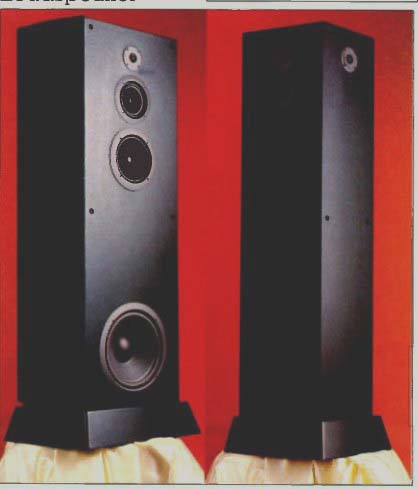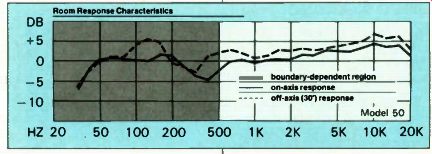
Dimensions: 20 1 / 2 by 48 1 / 2 inches (front), 16 inches deep.
Price: $2,000 per pair.
Warranty: Limited, five years parts and labor.
Manufacturer: DBX, 71 Chapel St., Newton, Mass. 02195.
Stemming from a short but distinguished lineage, the Soundfield 50 is the tallest and most visually distinctive of DBX's Soundfield Imaging loudspeakers. Since they were first introduced, Soundfield speakers have had as their primary design goal the production of a stable stereo image audible from a wide listening area. Listen Anywhere, goes the DBX trademark.
The principle behind Soundfield Im aging (another trademark) is quite simple: In order to maintain the stereo image as the listener approaches one loudspeaker, the other loudspeaker be comes louder. In this way, even though the sound from the nearer loudspeaker is the first to arrive at the listener's ears (and thereby would shift the image to ward that speaker), the louder sound from the farther loudspeaker "pulls" the image back to where it should be. DBX's innovation with its Soundfield speakers was to perform the time/ intensity trade off using a deliberately offset, oval shaped loudspeaker radiation pattern, with each speaker's most intense radiation directed at the other's.
The Soundfield One generated the required radiation pattern directly by use of a phased array of drivers to create an oval omnidirectional response. DBX's most recent models, such as the Sound field 50, are simpler (the company calls them "180°" models) and take advantage of the reflective properties of the wall be hind the speaker to help generate the "back" half of the Soundfield radiation pattern.
Also assisting with that task in the Soundfield 50 is the striking new-wave, new-age, postmodern, high-tech, fashion-statement enclosure. Trapezoidal in its horizontal cross section, the widest of the four panels is actually the black painted back of the speaker, which carries the unit's multiway binding-post connectors. The second-widest panel holds most of the drivers (one 10-inch woofer, one 6 / 2 -inch midrange, a 4-inch upper-midrange, and a 3-inch wide-dispersion tweeter). Rather than facing for ward, this panel instead faces the other speaker. The narrow front panel carries only a 3-inch tweeter while the slightly wider, outward-facing panel has yet another 3-inch tweeter and the system's vent.
The Soundfield 50's "extra" side and front tweeters, which are necessary to maintain the Soundfield radiation pat tern at high frequencies, are driven through carefully designed phase-shift ing networks to achieve that end. The crossover is thus unusually complex for what is essentially a three-way system.

Crossover points are 200, 800, and 3,150 Hz.
DBX rates the Soundfield 50 at 4 ohms nominal impedance (with a 2.5 ohm minimum), which is precisely what Diversified Science Laboratories found.
The actual impedance curve has several minor peaks (7.6, 5.9, and 5.3 ohms at 40, 1,500, and 5,000 Hz, respectively) and dips (2.7, 2.8, 2.9, and 2.5 ohms at 120, 700, 2,500, and 16,000 Hz), but they are arrived at smoothly and average out to about 4 ohms. As with other Sound field speakers, sensitivity is relatively high and allows the 50s to generate substantial amounts of sound with moderate-power amplifiers.
In DSL's 300-Hz pulse test, the speaker accepted the full output of the test amplifier (465 watts, or 26.7 dBW) and delivered therewith a calculated peak sound pressure level (SPL) of an extremely loud 119.7 dB at 1 meter. Harmonic distortion was very low and can be disregarded as a major contributor to the speaker's sonic character. Distortion remained well below 1 percent at most test frequencies with the three lower test levels (85, 90, and 95 dB SPL). At 100 dB SPL, bass distortion was still low (less than 1'A percent from 80 Hz on down), but high-frequency distortion started inching past 1 percent above 1 kHz.
The lab tested the Soundfield 50 placed 8 inches from the wall behind it.
In this position, the speaker's room-corrected 'A-octave response was extremely flat-with one notable exception-when measured at one meter on-axis (for this speaker, that means directly in front of the enclosure, not in front of the main speaker panel). Were it not for the approximately 6-dB dip around 400 Hz visible in our graph, possibly caused by interference from a floor reflection, the speaker's response could be rated as a very flat ±2 1 / 2 dB from 50 Hz to 20 kHz.
The off-axis measurement was quite similar to the on-axis response. However, the lower-midrange dip moved down to 250 Hz in the off-axis measurement.
We started our listening tests with the speakers placed according to DBX's recommendation (which is 1 to 1.5 feet from the backing wall and 8 to 12 feet apart). Our initial impression of the sound balance was one of forwardness and bright ness. This quality is usually found only in speakers with a raised lower-treble response. But since the Soundfield 50s are unusually flat in their response above 1 kHz, we must attribute the perceived balance to the relative lack of energy being produced in the 400-Hz region--the area responsible for musical "body"--abetted by a gradual rise at the very top frequencies (visible in both on- and off axis responses). Some of the forwardness disappeared when we moved the speakers up against the wall, a position which also makes for a much less cluttered listening room.
As can be expected from a speaker with a relatively flat response over a wide angle of radiation, the Soundfield 50 does not have a trace of the "boxiness" typically associated with highly colored off-axis radiation. Indeed, the Sound field 50 is among the least boxy-sounding speakers we have tested since we examined the Soundfield One.
The skewed-radiation Soundfield Im aging techniques again succeed with the Soundfield 50. It is a strange sensation to walk right up to one speaker and have the speaker of the opposite channel seem to increase in relative volume. The effect on the stereo image is startlingly minor: It remains where it was. There is a slight shift toward the nearer speaker when listening very far from the center line be tween the enclosures, but the image usually stays put.
Although not razor-sharp, the image is at least as good as that obtained from typical forward-radiating speakers. The image also has the distinct advantage of not sounding as if it originates with the two enclosures-it seems to float at one end of the listening room with no audible means of support (the Soundfield One was even more striking in this respect). Image depth, as befits this sound quality, can be very great--depending, naturally, on the recording. All these effects are available from other speakers that radiate substantial amounts of energy away from the listener, but are usually accompanied by an imaging precision inferior even to that of conventional speakers.
While moving around our listening room testing the Listen Anywhere imaging, we realized that the wide listening area provided by the Soundfield 50 has a benefit unacknowledged by DBX's literature on the speaker: You can choose a listening position that provides the best frequency response while keeping the speakers in a conventional location and while maintaining image quality. Specifically, you can locate the prime listening position where the conjunction of the room's standing waves allow the flattest bass response. This is usually not along one of a rectangular room's three center axes. With normal forward-radiating speakers placed symmetrically in the room, you'd have to sit along one of these lines to obtain the best imaging.
With the Soundfield 50s, movement away from a room axis, even by only a few inches, can have a noticeable and beneficial effect on bass reproduction without the accompanying change in image that can occur with conventional speakers.
In sum, we recommend the Soundfield 50s for serious auditioning, especially if, like us, you don't stay absolutely put during a listening session or if your listening-room layout prevents the traditional equilateral-triangle speaker/listener arrangement. Listen Anywhere is more than an advertising slogan: It accurately describes one of this speaker's strongest traits.
Also see: